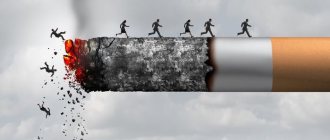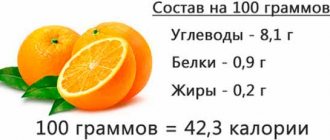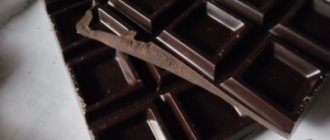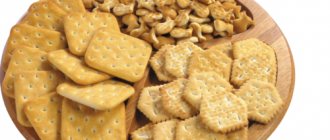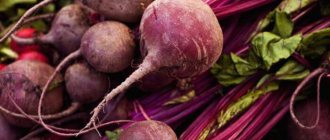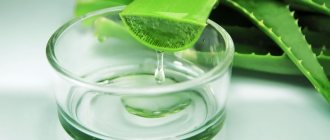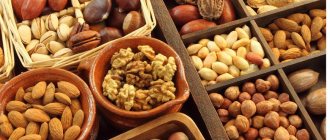As you know, smoking is a harmful habit that can cause the development of lung cancer and other equally serious diseases. If a smoker suffers from pancreatitis, then this is doubly dangerous and requires immediate cessation of cigarettes. Tobacco and its smoke, penetrating into the patient’s body, cause instant progression of pancreatitis and its rapid transition to a chronic form. Even with high-quality and timely treatment, it will not be effective if we are talking about a smoker, therefore smoking with pancreatitis quite clearly has a negative effect.
The effect of tobacco on the condition of the pancreas
Smoke carries more than 4 thousand components of varying concentrations that are harmful to the human body. The most dangerous are:
- nicotine;
- carcinogens;
- carbon monoxide;
- nitrogen dioxide;
- formaldehyde;
- ammonia;
- hydrogen cyanide;
- polonium-210.
All these components actively interact with each other, creating toxic compounds that can be said to confidently destroy the body day after day.
Smoking cigarettes means having an extremely negative effect on the pancreas and contributing to its destruction. This manifests itself as follows:
- the amount of pancreatic juice secreted into the duodenum decreases, which can seriously complicate the digestion process;
- endocrine function of the gland decreases;
- there is a failure in the synthesis of insulin and glucagon in the pancreas;
- there are problems with the production of an important component of pancreatic juice - bicarbonate;
- Damage to organ tissue occurs due to free radicals, which is caused by a decrease in the supply of vitamin A and C, as well as a decrease in the serum level of blood antioxidants;
- the process of calcium deposition in the gland occurs (calcification);
- In some cases, it is possible to increase the likelihood of developing pancreatic cancer.
It can be noted that active and heavy smokers begin to suffer from inflammation of the organ about 5 years earlier than other categories of patients with pancreatitis.
Mechanism of negative impact
The digestion process begins from the moment food enters the mouth. The secretion of saliva triggers the work of all endocrine glands. They produce enzymes necessary for complete digestion.
When smoking, caustic tars and smoke cause the salivary glands to work harder. The stomach secretes acid, the pancreas and gallbladder are filled with secretions, and the intestines activate peristalsis. But instead of a lump of food, the system receives only saliva full of resins, carcinogens and heavy metals.
Nicotine and toxic compounds cause spasm of the ducts, as a result of which the glands cannot empty themselves and enzymes begin to “digest” the organ itself.
Each episode of tobacco use provokes the following changes in the pancreas:
- Spasm of Vater's nipple under the influence of nicotine. As a result, the amount of secretion decreases and its natural outflow is disrupted. The lumps of food in the duodenum do not receive enough enzymes to dissolve. A person feels pain in the epigastrium, heaviness and distension.
- Chronic tissue inflammation due to the retention of digestive juice over time leads to pancreatitis and cell death - pancreatic necrosis.
- Calcification of tissues and formation of crystalline elements in the ducts.
- Decreased endocrine function. As a result of cell death, insulin production is disrupted, which inevitably leads to the development of type 2 diabetes.
- Atherosclerosis of blood vessels, their blockage. The formation of microthrombi and even organ infarction is possible.
- The formation of pseudocysts, scar tissue instead of dead cells, organ obesity and the growth of tumors, including malignant ones.
Composition of tobacco smoke
Despite the large number of articles on the Internet about this bad habit, most still have no idea how smoking affects pancreatitis and whether it is possible to smoke with pancreatitis.
But first, it’s worth understanding some information, for example: what substances are included in tobacco smoke from cigarettes. So, for general information, it is worth knowing that smoke contains up to 12,000 different substances and chemical compounds, among them 196 are poisonous, and 14 are narcotic, which is what causes addiction in people. And here is a list of substances that a smoker inhales:
- nicotine 0.8 – 3 mg;
- hydrocyanic acid 1.3 mg;
- aromatic amines 0.00025 mg;
- carbon dioxide (carbon dioxide) 45 - 65 mg;
- carbon monoxide (carbon monoxide) 10 - 23 mg;
- benzene (one of the components of gasoline) 0.012 - 0.05 mg;
- methanol (poisonous liquid with a pungent odor) 0.08-0.18 mg.
In addition to these elements, radioactive substances are also present.
Since the topic of components has been touched upon, it is worth considering the popular electronic cigarettes today. Readers are presented with substances that the liquid of a standard electronic device contains:
- from 55 to 62% - propylene glycol;
- from 30 to 35% - glycerin;
- from 0 to 3.6% - nicotine;
- from 2 to 4% - flavorings;
- water in appropriate concentration.
The connection between smoking and pancreatitis
The influence of smoking on the course and treatment of pancreatitis has been established for a long time. In the course of research, it was revealed that with the same approach to treatment, smokers succumb to it much more difficult than non-smoking patients.
In addition, the rehabilitation period can significantly increase, and the likelihood of relapse soars to 58 percent of cases if the patient continues to smoke. It is also important to note that the risk of complications can be equated to the number of cigarettes that were smoked.
Due to the prolonged period of treatment, the pancreas remains in an inflamed state for quite a long time, which leads to modifications in its glandular tissue, leading to the development of diabetes mellitus, malfunctions of the digestive system and even more dangerous organ diseases.
If, against this background, a person still regularly abuses alcoholic beverages, then in almost 100 percent of cases this leads to inflammation of the pancreas, and at the same time, if you smoke, inflammation of the pancreas and its treatment will become inevitable.
Complications of smoking
A cigarette contains 3,000 substances hazardous to human health. The first group of toxins consists of resins that produce an irritating effect on the lungs and bronchi, the gastrointestinal tract, the second is nicotine, which causes drug addiction, the third is toxic gases: carbon monoxide, nitrogen, hydrogen cyanide.
Cigarette use for pancreatitis provokes a number of other diseases:
- cardiovascular failure;
- pseudocyst formation;
- enlarged spleen;
- venous insufficiency;
- diabetes mellitus (when patients smoke more than 1 pack per day);
- stone formation;
- liver dysfunction;
- disruption of the gastrointestinal tract;
- stomach ulcer;
- lung disease (fluid accumulation in the membranes).
The risk of disease increases when consuming more than a pack of cigarettes per day. Smoking with pancreatitis negates the treatment of the pancreas, provokes salt deposition, and disrupts blood flow. Nicotine increases the likelihood of the disease returning again (relapse).
What should those who want to quit smoking remember?
An important point remains the correct disposal of harmful addiction. For patients with pancreatitis, regular chewing gum, nicotine patches, pills or lozenges are not suitable. All these drugs activate the secretion of enzymes by the damaged organ and aggravate the course of its inflammation.
The only adequate way out of the situation is the patient’s powerful willpower and psychological support from his relatives and friends. This is the only way to stop smoking once and for all without additional harm to the digestive system.
Today, statistics show that more than half of adults around the globe suffer from the harmful habit of smoking. This can be explained by the temporary antidepressant and calming effects of nicotine on the body. In addition, tobacco is not on the list of prohibited drugs. This destructive habit is the cause of the development of very serious diseases: destruction of the cardiovascular system, lung cancer, infertility, myocardial infarction, pneumonia, atherosclerosis, pancreatitis. That is, the conclusion suggests itself. Smoking during pancreatitis is strictly contraindicated. If the patient has been diagnosed with this disease, then it is necessary to immediately quit the addiction. The article talks about this in more detail.
What can be the complications of pancreatitis?
Aggravating the course of the disease include:
- organ calcification (active formation of stones);
- development of exocrine insufficiency;
- the appearance of pseudocysts.
It should be noted that the starting point of acute pancreatitis is prolonged alcohol consumption, and smoking is its catalyst. Those who drink more than 400 grams of alcoholic beverages per month increase the likelihood of organ inflammation by about 4 times, but this does not mean that smoking with pancreatitis is possible.
Quitting a bad habit
The main target of the toxic effects of smoking is on the human nervous system. After the formation of a physical and mental addiction, quitting smoking provokes a dependence syndrome, thus preventing a person from getting rid of the habit. As a rule, it is quite difficult to cope with such a task alone. Therefore, many recommend making an appointment with a professional psychologist.
If you smoke for a long time, then you need to remember that you cannot get rid of such a bad habit too abruptly. In such situations, it is necessary to quit gradually, preparing for a short-term weakening of the immune system.
How to regain attractiveness after quitting smoking
The first thing you need to do to regain your attractiveness is to quit smoking forever. Over time, the body will be cleansed of cigarette poison, metabolism and cellular regeneration mechanisms will be activated. The face will become fresher and the jaundice will go away. After normal functioning of the sebaceous glands is restored, inflammation will disappear.
For girls who smoke for a short time, their beauty will be restored within a few months of intensive care. When a woman has been “smoking” for several years, she will have to prepare for the fact that this process will take much longer.
To help your skin quickly gain youth and beauty, you need to regularly use nourishing creams enriched with vitamins A, E, F, and coenzyme Q10. These substances help stop skin aging. Before going outside, you should apply products with filters that protect against ultraviolet radiation, so as not to injure the damaged epidermis.
In addition to external care, it is necessary to support the body from the inside by normalizing nutrition and daily routine.
Nutrition when quitting smoking
During the rehabilitation period, it is important to saturate the body with missing vitamins and microelements in order to establish metabolic processes, cleanse yourself of tobacco toxins, and reduce the risk of stress overeating.
The basis of the diet for detoxifying the body should be lean meat and fish, fresh vegetables, fruits, cereals and dairy products.
You need to limit (or temporarily eliminate) your consumption of:
- sweets;
- hot seasonings;
- packaged juices;
- smoked meats;
- alcohol;
- semi-finished products;
- flour;
- carbonated drinks;
- spices.
For better appetite control, split meals are recommended at regular intervals. Dishes should be boiled, baked or steamed; fatty and fried foods should be avoided.
The skin will recover faster if you drink two liters of clean water a day. Additionally, you can take vitamin complexes.
Folk remedies for restoring skin after smoking
Cosmetics prepared at home will help speed up the cleansing of the body from the effects of long-term smoking. Preparing cleansing masks is very simple; the ingredients for them are available in any pharmacy.
Here are some popular recipes:
- 2 tbsp. dilute blue cosmetic clay with water to the consistency of thick sour cream, add a couple of drops of your favorite essential oil;
- 1 tbsp. pour boiling water over ground oatmeal and beat to form a homogeneous mass. Use liquid honey or avocado pulp as a binder;
- To give your favorite face mask detox properties, pharmaceutical sorbents are suitable: polysorb, enterosgel, activated carbon;
For the effect to be noticeable, a course of procedures is needed. Comprehensive skin care will help distract you from the desire to smoke, and the visible result will reinforce your willpower.
The body's response to nicotine
A bad habit can start the process of enzyme production. This happens because the process of irritation of the mucous membrane starts. First, harmful substances enter the mouth and cause the production of saliva. At the same time, the brain begins to send active signals to the gastrointestinal tract so that the pancreas begins to produce juice.
As a result of this, the digestive tract is completely ready to receive food, but only receives saliva enriched with ammonia, tar and nicotine. The latter begins to influence the hypothalamus, activating the center that is responsible for saturation.
Under the influence of nicotine, pancreatic juice is not able to enter the duodenum for complete digestion, which causes the onset of an inflammatory process in the pancreas, and every time a person plans to smoke, this is exactly what awaits him.
As a result, serious damage to the organ is caused, because if the described mechanism is repeated frequently when smoking, especially on an empty stomach, the gland stops returning to normal. Of course, these are not echo signs of diffuse changes in the parenchyma, but you shouldn’t joke with the pancreas.
We must not forget the fact that nicotine promotes vasospasm. From this, a pattern emerges that heavy smokers experience any processes in their pancreas, in particular inflammatory ones, much more acutely and more difficultly. The blood supply deteriorates, thereby prolonging the acute period of the disease and preventing the recovery of the affected organ.
What to do? Prevention and treatment
Regardless of the causes, treatment of pancreatitis consists of reducing the inflammatory process, eliminating pain, correcting dysfunction of the pancreas, further preventing the development of the disease and treating complications.
The first thing you need to do is to give up all junk food (fried, smoked, fatty), drinking alcohol, smoking; adhere to a diet low in animal fats and strictly follow the instructions of your doctor. To eliminate and relieve pain, narcotic and non-narcotic analgesics are used, as well as pancreatic enzymes, which are prescribed in the required dose by a doctor.
During the prevention of pancreatitis, which consists of preventing the development of complications and stopping the progression of the inflammatory process, the patient is under the supervision of a doctor and undergoes a medical examination about twice a year.
In any case, if you suffer from chronic pancreatitis, it would be right to give up all bad habits that can only aggravate the condition and also contribute not only to the development of this disease, but also to the emergence of new ones. This way you will take an important step towards a speedy recovery and a return to a full life, unencumbered by constant pain, poor health and a strict diet.
Your narcologist warns: why is smoking in combination with alcohol especially dangerous for the organ?
Often, smokers do not even realize that abdominal discomfort is caused by smoking. It would seem that pancreatic diseases are not associated with cigarette smoking. The opinion that smoking only affects the organs of the respiratory system is erroneous. Smoking also harms the abdominal organs.
The largest gland in the body, which has endocrine and exocrine functions, is the pancreas. Pancreatitis is an inflammatory disease of the gland. There are two types:
- acute pancreatitis - occurs quickly, with severe pain;
- Chronic pancreatitis is sluggish and the patient may not be aware of it for years.
Abdominal pain is a symptom characteristic of both forms of pancreatitis. Localized in the upper abdomen, it can radiate to the spine and scapula. When it predominates on the left and radiates under the shoulder blade, it can be confused with a heart attack. Severe and sharp pain is observed in acute pancreatitis; in chronic pancreatitis, it is dull and occurs after eating.
Other symptoms are almost the same for both forms of the disease:
- frequent urge to vomit;
- general weakness and fatigue;
- problems with stool (diarrhea and constipation);
- weight loss;
- flatulence;
- belching;
- heartburn.
Acute pancreatitis requires immediate medical attention.
Tobacco affects the development of pancreatitis and prevents healing. The longer pancreatitis progresses in the body, the higher the risk of developing cancer. This information is reliable and supported by scientific research.
Those who have had chronic pancreatitis for more than 5 years and continue to smoke have a tenfold higher risk of developing cancer than those who do not smoke.
In people who smoke, pancreatic juice is constantly produced, the gland works continuously. This is explained by the fact that when tobacco smoke enters the oral cavity, it irritates the mucous membrane and salivary glands, and the process of salivation begins, although normally this should occur when food enters the oral cavity.
Daily smoking constantly repeats this pathological mechanism, which causes serious damage to the gland. Inflammation in smokers is more acute and longer, the reason for this is the constant spasm of blood vessels caused by nicotine and poor circulation in the organ.
Scientific studies have shown that pancreatic cells responsible for producing hormones die or do not function fully when exposed to nicotine.
Alcohol consumption, like smoking, is a key cause of pancreatitis. The symptoms of alcoholic pancreatitis mimic those of a smoker's pancreatitis. But there are also specific ones:
- the pancreas does not produce enzymes that can neutralize alcohol, so the toxic effect of alcohol on it is higher than, for example, on the liver;
- when drinking alcohol, protein plugs (stones) are formed in the gland tissue;
- Those who abuse alcohol are more likely to develop cholelithiasis, the stones block the excretory ducts of the pancreas and pancreatic juice accumulates inside.
Non-drinkers, like non-smokers, suffer from pancreatitis much less often; pancreatitis in such people is associated to a greater extent with poor nutrition.
Drinking alcoholic beverages, even in small quantities and infrequently, still leads to the development of the disease; there is no exact data on the minimum safe dose of alcohol. Most likely, it simply does not exist.
Both factors provoke severe inflammation of the gland, which cannot be relieved without giving up bad habits.
Smoking is a factor in the development of complications in patients with pancreatitis. Upon learning of the diagnosis, you need to quit smoking immediately, this is the first important step towards recovery.
Smoking during pancreatitis contributes to the development of pancreatic cancer due to the fact that it provokes the development of inflammation, which prevents the treatment process from achieving a successful result. Smoking impairs blood circulation in the pancreas (as in any other organ), which also impedes recovery.
In acute pancreatitis, a smoker experiences more pain than a non-smoker.
Smoking affects a patient with pancreatitis in the following ways:
- there is a deficiency of vitamins A and C;
- the production of bicarbonate, which is a key component of gastric juice, is impaired;
- Digestion worsens.
The key to successful treatment of pancreatitis is a healthy balanced diet 4-5 times a day in small portions. Smoking suppresses appetite in patients and causes a false feeling of fullness. This leads to skipping meals and recovery does not occur.
Smoking nicotine-containing hookah mixtures and e-cigarette liquids is prohibited if you have pancreatitis. But, if you can’t give up cigarettes at all, you can temporarily use a vape.
Vapes and hookahs do not contain tar, unlike cigarettes, and are therefore less harmful. It is best to use mixtures and liquids that do not contain nicotine; they do not harm the pancreas.
It is important for a smoker suffering from pancreatitis to know:
- You need to give up cigarettes immediately upon diagnosis; gradually reducing the number of cigarettes you smoke will not help; even one cigarette a day aggravates the course of pancreatitis and increases the risk of cancer or diabetes.
- Don't be afraid to seek help from a psychotherapist. Not everyone is able to cope with addiction on their own using willpower or finding the right motivation.
For diseases of the pancreas, doctors do not recommend the use of nicotine replacement therapy: patches, chewing gum, aerosols and lozenges. But, as a temporary therapy, if you cannot quit on your own and quickly, nicotine replacement therapy will cause less harm than smoking cigarettes.
The therapist will help you choose safe medications to relieve physical cravings for cigarettes, and the psychotherapist will help with motivation and combating the stress of quitting.
Thoughts about healing, the disappearance of pain, discomfort, and digestive problems will help motivate yourself. It is better to spend the money saved from purchasing cigarettes on gifts for yourself, purchases that you could not afford before.
Don't worry about weight gain; a diet for pancreatitis will prevent this.
For successful treatment, you must follow the rules:
- normalization of nutrition - a ban on spicy, fried, fatty foods;
- eating strictly 4-5 times a day in small portions;
- you need to quit smoking;
- strictly follow the prescribed treatment;
- completely stop drinking any alcoholic beverages;
- after completing a course of treatment, visit a doctor at least once every six months in order to prevent relapse of the disease;
- walk in the fresh air more often, normalize sleep;
- Upon completion of the course of treatment, light sports are recommended to strengthen the immune system and improve well-being.
Conclusion
Smoking, as a risk factor for developing pancreatitis, should be excluded from your life. It is argued that the occurrence of a dangerous disease directly depends on the frequency and length of smoking. It is a dubious pleasure to smoke, experiencing pain and discomfort, and risking contracting deadly diseases.
Smoking with pancreatitis coupled with alcohol consumption is fatal to pancreatic cells. The cumulative effect of spasm of the blood vessels supplying the organ, narrowing of the ducts, hypersecretion of juice and the external toxic effects of ethanol and nicotine leads to rapid and irreversible destruction of the pancreas.
https://www.youtube.com/watch?v=mNmn_IZzU0Q
Treatment of pancreatitis in smokers is usually delayed. The disease itself is accompanied by complications, and rehabilitation is lengthy and not always effective.
Pancreatitis can be acute or chronic.
Acute pancreatitis is characterized by sharp pain in the left side of the abdomen, which over time can become girdling, nausea, vomiting, a drop in blood pressure and a sharp deterioration in the general condition of the patient. Since in acute pancreatitis the free outflow of pancreatic juice is disrupted, which leads to the digestion of the gland by its own enzymes, this disease requires urgent surgical examination and hospitalization.
Chronic pancreatitis has two periods. In the initial period, the disease is expressed in pain and can proceed relatively unnoticed for several years. Pain is periodically felt in the upper and middle parts of the abdomen, the left lumbar region and half of the chest, and the heart region. It occurs 15-20 minutes after eating and is most often provoked by fried, fatty, smoked foods, as well as alcoholic, carbonated drinks, coffee, cocoa, chocolate and smoking. During prolonged pancreatitis, the ability of the gland to produce enzymes for digesting food decreases, and secretory insufficiency is formed. Pain is often absent or less pronounced, the patient develops exocrine insufficiency, which leads to bloating, mushy stools, weight loss, signs of hypovitaminosis, and ultimately contributes to the development of pancreatogenic diabetes mellitus.
Features of the pancreas
The organ consists of two types of tissue, which differ from each other in their functions. We are talking about their endocrine and exocrine roles. We can say that in almost 90 percent of the body of the gland there is acinar tissue, which is responsible for the production of pancreatic juice. The remaining 10 percent are the islets of Langerhans (special endocrine cells). They are responsible for the production of insulin, the main hormone of the human pancreas.
There is evidence that nicotine has an extremely negative effect on all organ cells. If the patient is not able to quit smoking in a timely manner, then all the clinical manifestations of pancreatitis only worsen, and the likelihood of the onset of calcification and cancer of the pancreas only increases several times.
Some features
Medical scientists in the United Kingdom conducted a large-scale clinical study that specifically concerned smokers with pancreatitis. Several key facts were established:
- The duration of therapy and its complexity in patients who had a bad habit were 45% higher than the same indicators compared to other subjects.
- To relieve the main symptoms, it was necessary to use a wider range of medications.
- The rehabilitation period for tobacco smoke lovers was 2 times longer than the normal recovery period.
- 60% of smokers necessarily experienced early relapses.
Similar studies conducted in Italy demonstrated a relationship between smoking and pancreatic calcification. In addition, it was found that the destructive habit significantly increases the risk of diabetes.
Motivation
The result of changing one's lifestyle can motivate a person. As a rule, a few months after quitting smoking, the lungs begin to cleanse, the blood is renewed, blood pressure normalizes, cough disappears, as well as constant headaches. Therapy for pancreatitis in this case will be much more productive, and the number of exacerbations will begin to decrease, and the likelihood of developing oncology will also decrease. And this, as mentioned earlier, provokes smoking during pancreatitis.
For those who quit
To improve lung function and pancreas function after quitting cigarettes, a special set of exercises is used:
- raising your arms to the maximum height, alternating with exhalation;
- postural drainage - performed in a lying position, alternately - first on the right, then on the left sides in order to accumulate sputum and further get rid of it with the help of expectorants.
Effective treatment of pancreatitis depends on timely consultation with a doctor and correct diagnosis. But a lot depends on the patient: it is necessary to strive for a healthy lifestyle and get rid of bad habits. Pancreatitis and smoking are incompatible!
Purpose of chewing gum
Chewing gum is considered a culinary product. Its main purpose is:
- Breath freshening.
- Getting rid of bad breath.
- Cleaning the teeth and surface of the tongue from stuck food debris.
Prototypes of chewing gum can be found back in ancient times. For example, the Greeks chewed the resin of the mastic tree to clean their teeth and freshen their breath, the Mayan tribes chewed rubber, and the Indians chewed the resin of coniferous trees.
Compound
The formula for modern gum was developed back in 1928 by accountant Walter Diemer. According to this document, the product must contain:
| Component share | Product |
| 20% | Rubber |
| 60% | Sugar/sweetener |
| 19% | Corn syrup |
| 1% | Corn syrup |
In the modern composition of many chewing gums, the amount of flavors, dyes, and taste fixatives is slightly changed and reaches 5%. Some products also contain polyols, which have a laxative effect.
Dyes used in chewing gum must be included in the international list of approved harmless chemicals. Unfortunately, this list grows every year, and previously prohibited substances become permitted.
As a result of the latest study of modern chewing gum, the following beneficial and harmful chemicals were discovered in their composition:
| Group | Name | Impact on the body |
| Useful | E 953, E 967 | Prevents the development of caries. |
| E 421 | Accelerates the removal of toxins from the body. | |
| Ascorbic acid | Increases the body's protective functions. | |
| Harmful | Acesulafam K, E 321 | It is a carcinogen, increases the risk of cancer, and disrupts intestinal function. |
| E 420 | It has a laxative effect and can cause digestive upset. | |
| E 951 | The accumulation of this substance in the body causes headaches, tinnitus, allergic reactions, sleep disturbances, and deterioration of the emotional state. | |
| E 171 | Harmful effects on the liver and kidneys. | |
| E 967 | Promotes the formation of kidney stones. | |
| E 320 | Capable of destroying vitamin substances. |
Therefore, when choosing chewing gum, it is very important to pay attention to its composition. It is also recommended to avoid additives E 171, E 102, E 129, E 432, as they cause harm to the liver.
Examination of an alcohol addict for suspected pancreatic inflammation
It is almost impossible to detect alcoholic pancreatitis until the pancreas tissue is significantly damaged. In the first stages of the disease, the inflammatory process is not visualized during ultrasound. There are no characteristic changes in the results of laboratory tests. Painful symptoms in a patient occur when the organ becomes severely swollen and inflamed. All this makes it difficult to make a correct diagnosis.
The doctor pays attention to the fact of alcohol consumption and signs characteristic of pancreatitis - nausea, flatulence, diarrhea, abdominal pain. Tests usually reveal markers of inflammation - leukocytes and ESR increase. These are dangerous signals that cannot be ignored. In biochemistry, an increase in the concentration of gamma-glutamyl transpeptidase is recorded. This enzyme confirms damage to the pancreas and the presence of chronic alcoholism.
In the urine, they look at the levels of albumin, transferrin and glucose. They are also elevated. In stool analysis for pancreatitis, fatty acids, dietary fiber and neutral fat are detected.
Healthy ecological chewing gum
All popular chewing gums (Orbit, Dirol, Stimorol) contain harmful chemical additives. However, today there is an excellent replacement for these products in the form of ecological chewing gum. They are made from natural, degradable natural ingredients and do not harm the environment or the human body.
These chewing gums include the following:
| Name | Description |
| Simply Gum | Made from glycerin, raw sugar, rice flour and natural flavors. This chewing gum freshens breath well, prevents the development of caries, improves mood, cleanses the oral cavity of food debris and does not cause harm to the gastrointestinal tract. |
| Chicza Gum | Consists of chicosapote tree resin, powdered sugar cane syrup, agave syrup and natural flavors. |
| Taiga resin | Larch resin, extracts of plant raw materials depending on the type of flavor of the product. Has antioxidant, anti-inflammatory, antimicrobial capabilities. |
| Baikal sulfur | Made from Siberian larch resin. Does not contain flavorings, sugars or preservatives. Helps strengthen teeth, has antioxidant and antibacterial properties. |
| Nature Dent | These products are based on oleoresin from Boswellia trees. Improves memory and blood flow, normalizes sleep and hormonal levels. |
Natural chewing gum does not pose a danger to the body. Moreover, they have a number of useful properties.
However, in case of diseases of the digestive organs, they can only be consumed with the permission of a doctor. This is explained by the fact that in many ailments (ulcers, gastritis, hyperacidity, pancreatitis), the harm lies in the process of chewing and salivation.
Comments
To be able to leave comments, please register or log in to the site.
Smoking is a bad habit that negatively affects the functioning of individual organs and the functioning of the entire body. Smoking is extremely dangerous for pancreatitis; it aggravates the disease, interferes with treatment, and contributes to complications and relapses. If it was previously believed that alcohol is one of the main causes of pancreatitis, recent research by scientists has proven that smoking also has a significant negative effect on patients with this disease. Even the term “nicotine pancreatitis” appeared, along with “alcoholic pancreatitis,” to designate cases of the disease that arose and occur due to smoking, which significantly worsens the overall picture of the disease.
Pancreatitis - causes and symptoms
Pancreatitis is a disease of the pancreas in which a progressive inflammatory process leads to damage to the gland and changes in its functions, which in turn leads to significant metabolic disorders in the body. Since the pancreas produces gastric juice and ensures the regulation of carbohydrate metabolism, as well as the efficiency of the process of digesting food in the body, any failure in its operation leads to a change in the functioning of the entire digestive system.
The main causes of pancreatitis are:
- poor nutrition
- deterioration of the environmental situation
- alcohol abuse
- frequent consumption of spicy, fatty, smoked and fried foods
- endocrine diseases
- diseases of the duodenum and stomach
- viral infections
- hereditary pancreatitis
- smoking
- pathology of the hepatobiliary system
- severe food allergies
- taking medications
How to chew gum correctly without harm to health
In order not to cause harm to the digestive organs, you should adhere to the following rules:
- Choose chewing gum with the least harmful composition.
- Use the product only after meals.
- Chew gum for no more than 2-5 minutes.
- Throw away the used product immediately, do not swallow or reuse.
- Chew gum in an amount of no more than 2 sticks per day.
One of the most important rules for using chewing gum is to never replace it with food. Chewing gum will in no way satisfy hunger, but will further increase appetite, and if taken on an empty stomach, it will damage the mucous membranes of the digestive organs and provoke their irritation with all the ensuing painful symptoms.
Signs indicating damage to the pancreas by alcohol
In fact, you don’t have to drink for weeks or months to experience pancreatitis. In some cases, it is enough to take a large dose of the “hot” once.
The disease can occur in acute and chronic form. The first is characterized by:
- discomfort in the upper abdomen;
- girdle pain under the ribs;
- frequent nausea;
- vomiting (and relief does not come even after vomiting);
- painful cramps in the stomach.
It is very important to recognize pancreatic inflammation in time, when it is still possible to reverse the pathological process. If you do not seek medical help at the first symptoms, the disease will become chronic. Then the alcohol addict will be tormented:
- constant nausea and vomiting;
- diarrhea;
- aching pain in the right hypochondrium;
- flatulence.

